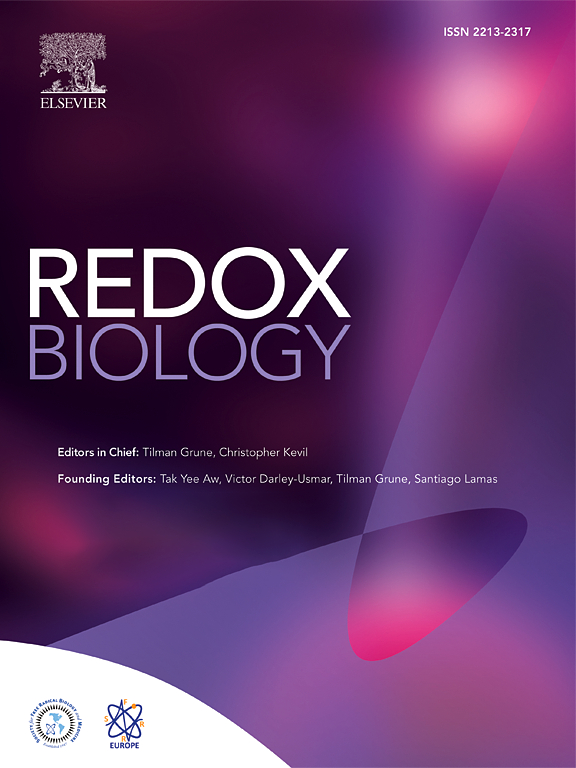Acute stimulation of glucose metabolism by H2O2 sustains the NADPH steady-state under oxidative stress
IF 11.9
1区 生物学
Q1 BIOCHEMISTRY & MOLECULAR BIOLOGY
引用次数: 0
Abstract
Oxidative stress reprograms metabolic flux from glycolysis to the pentose phosphate pathway. Recently, it has been proposed that NADPH acts as a key molecule in pentose phosphate pathway regulation by exerting negative feedback through tonic inhibition of glucose-6-phosphate dehydrogenase. Interestingly, recent studies show that NADPH levels remain stable during acute exposure to hydrogen peroxide in the presence of glucose, ruling out NADPH-dependent feedback inhibition. We hypothesize that hydrogen peroxide triggers a feedforward activation mechanism, increasing NADPH production even before any detectable NADPH depletion. To probe this hypothesis, we used a panel of genetically encoded fluorescent indicators to monitor glucose, NADPH, fructose 1,6-bisphosphate and pyruvate in single cells with high temporal resolution. Our results reveal that hydrogen peroxide rapidly activates glucose transport and consumption rates, enabling cells to preserve NADPH steady-state levels during early oxidative stress. Notably, this response precedes NADPH depletion, implying an anticipatory phenomenon that boosts NADPH production prior to its consumption. Furthermore, hydrogen peroxide induced an acute perturbation of fructose 1,6-bisphosphate steady-state and an increase of pyruvate accumulation. The pharmacological inhibition of the PPP’s gateway enzymes, glucose-6-phosphate dehydrogenase and transketolase, abolished the hydrogen peroxide-dependent alterations in fructose 1,6-bisphosphate steady-state levels and pyruvate accumulation, respectively. These findings suggest that a substantial fraction of glucose-derived carbon flux is diverted to the pentose phosphate pathway under oxidative stress, underscoring the importance of feedforward control in maintaining redox balance.

H2O2对葡萄糖代谢的急性刺激维持了氧化应激下NADPH的稳定状态
氧化应激将代谢通量从糖酵解重编程为戊糖磷酸途径。最近有研究提出,NADPH通过强直抑制葡萄糖-6-磷酸脱氢酶发挥负反馈作用,作为戊糖磷酸途径调控的关键分子。有趣的是,最近的研究表明,NADPH水平在急性暴露于葡萄糖存在的过氧化氢时保持稳定,排除了NADPH依赖的反馈抑制。我们假设过氧化氢触发前馈激活机制,甚至在任何可检测到的NADPH耗尽之前增加NADPH的产生。为了验证这一假设,我们使用了一组基因编码荧光指示器,以高时间分辨率监测单细胞中的葡萄糖、NADPH、F1、6BP和丙酮酸。我们的研究结果表明,过氧化氢迅速激活葡萄糖运输和消耗速率,使细胞在早期氧化应激期间保持NADPH稳态水平。值得注意的是,这种反应先于NADPH耗竭,这意味着一种预期现象,即在NADPH消耗之前促进其产生。此外,过氧化氢诱导F1、6BP稳态的急性扰动和丙酮酸积累的增加。药理抑制PPP的门户酶葡萄糖-6-磷酸脱氢酶和转酮醇酶,分别消除了F1、6BP稳态水平和丙酮酸积累的过氧化氢依赖性改变。这些发现表明,在氧化应激下,葡萄糖来源的碳通量的很大一部分被转移到戊糖磷酸途径,强调了前馈控制在维持氧化还原平衡中的重要性。
本文章由计算机程序翻译,如有差异,请以英文原文为准。
求助全文
约1分钟内获得全文
求助全文
来源期刊

Redox Biology
BIOCHEMISTRY & MOLECULAR BIOLOGY-
CiteScore
19.90
自引率
3.50%
发文量
318
审稿时长
25 days
期刊介绍:
Redox Biology is the official journal of the Society for Redox Biology and Medicine and the Society for Free Radical Research-Europe. It is also affiliated with the International Society for Free Radical Research (SFRRI). This journal serves as a platform for publishing pioneering research, innovative methods, and comprehensive review articles in the field of redox biology, encompassing both health and disease.
Redox Biology welcomes various forms of contributions, including research articles (short or full communications), methods, mini-reviews, and commentaries. Through its diverse range of published content, Redox Biology aims to foster advancements and insights in the understanding of redox biology and its implications.
 求助内容:
求助内容: 应助结果提醒方式:
应助结果提醒方式:


